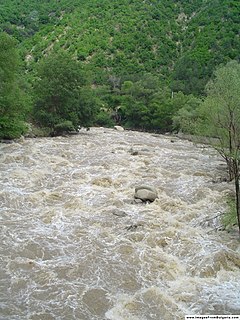
Fraxinus, English name ash, is a genus of flowering plants in the olive and lilac family, Oleaceae. It contains 45–65 species of usually medium to large trees, mostly deciduous, though a number of subtropical species are evergreen. The genus is widespread across much of Europe, Asia, and North America.

Kresna Gorge is a steep valley in south-western Bulgaria, stretching about 18 km. The gorge has been formed by the Struma River, which flows from the Vitosha mountains. Kresna gorge has a rich biodiversity, which has come under pressure from the Struma motorway construction project, a new leg of the Trans European Corridor No. 4. In the south, the gorge bisects the Tisata nature reserve.

The Appalachian mixed mesophytic forests is an ecoregion of the temperate broadleaf and mixed forests biome, as defined by the World Wildlife Fund. It consists of mesophytic plants west of the Appalachian Mountains in the Southeastern United States.

Fraxinus angustifolia, the narrow-leafed ash, is a species of Fraxinus native to central and southern Europe, northwest Africa, and southwest Asia.

The Appalachian–Blue Ridge forests are an ecoregion in the Temperate broadleaf and mixed forests Biome, in the Eastern United States. The ecoregion is located in the central and southern Appalachian Mountains, including the Ridge-and-Valley Appalachians and the Blue Ridge Mountains. It covers an area of about 61,500 square miles (159,000 km2) in: northeast Alabama and Georgia, northwest South Carolina, eastern Tennessee, western North Carolina, Virginia, Maryland, and central West Virginia and Pennsylvania; and small extensions into Kentucky, New Jersey, and New York.

Dalbergia cochinchinensis, the Thailand rosewood, Siamese rosewood, or tracwood, is a species of legume in the family Fabaceae.

The Illyrian deciduous forests is a terrestrial ecoregion in southern Europe, which extends along the eastern coast of the Adriatic Sea. It belongs to the Mediterranean forests, woodlands, and scrub biome, and is in the Palearctic realm.

The flora of Italy was traditionally estimated to comprise about 5,500 vascular plant species. However, as of 2019, 7,672 species are recorded in the second edition of the flora of Italy and in its digital archives Digital flora of Italy. In particular, 7,031 are autochthonous and 641 are non native species widely naturalized since more than three decades. Additionally, further 468 exotic species have been recorded as adventitious or naturalized in more recent times. Geobotanically, the Italian flora is shared between the Circumboreal Region and Mediterranean Region. According to the index compiled by the Italian Ministry for the Environment in 2001, 274 vascular plant species were protected.

The Italian sclerophyllous and deciduous forests ecoregion, part of the Mediterranean forests, woodlands, and scrub biome, is in Italy. The ecoregion covers most of the Italian Peninsula and includes both evergreen and deciduous forests.

The South Apennine mixed montane forests is an ecoregion in the southern Apennine Mountains of southern Italy and Sicily. It has a Mediterranean climate, and is in the Mediterranean forests, woodlands, and scrub biome.

The Tyrrhenian-Adriatic sclerophyllous and mixed forests is an ecoregion in southern Italy, Sicily, Sardinia, Corsica, the Dalmatian Islands of Croatia, and Malta.

The Dinaric Mountains mixed forests are a terrestrial ecoregion of the temperate broadleaf and mixed forests biome in Southeastern Europe, according to both the WWF and Digital Map of European Ecological Regions by the European Environment Agency. It also is in the Palearctic realm.

The Po Basin mixed forests is an temperate broadleaf and mixed forests ecoregion in the basin of the Po River in northern Italy and Switzerland's Ticino canton.

The Nera Gorge-Beușnița National Park is a protected area situated in Romania, in Caraş-Severin County.

Stara Reka is one of the nine nature reserves in the Central Balkan National Park in central Bulgaria. Stara Reka was established on 19 March 1981 to protect the unique ecosystems of the Balkan Mountains. It spans an area of 1974.7 hectares, or 19.747km2.

Tisata is a nature reserve in south-western Bulgaria. It is situated in Kresna Municipality, Blagoevgrad Province. The reserve is managed by the administration of Pirin National Park despite the fact it lies outside the limits of the park.

Orelyak is a nature reserve in the central section of the Pirin mountain range in south-western Bulgaria. It is situated in Gotse Delchev Municipality, Blagoevgrad Province. It was declared on 22 February 1985 to protect old growth beech forests it the vicinities of Mount Orelyak (2,099 m), the highest summit in Central Pirin. It spans a territory of 757 ha or 7.57 km2.

The wildlife of Sweden includes the diverse flora and fauna of Sweden. habitats include mountain heath, montane forests, tundra, taiga, beech forests, rivers, lakes, bogs, brackish and marine coasts and cultivated land. The climate is in general very mild for a country at this latitude, because of the significant maritime influence.

The Cantabrian mixed forests is a temperate broadleaf and mixed forests ecoregion in southwestern Europe. It extends along the coastal Cantabrian Mountains and Galician Massif of Northern Spain, extending south into northern Portugal, and northwards through the westernmost Pyrenees to southwestern France. The ecoregion extends from the seacoast to the highest peaks of the Cantabrian Mountains. The highest peak is Torre Cerredo at 2,648 meters elevation.


















